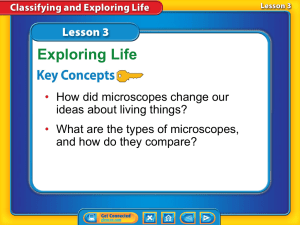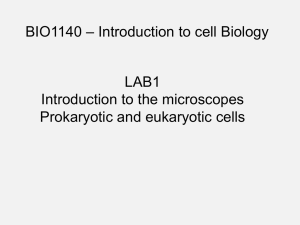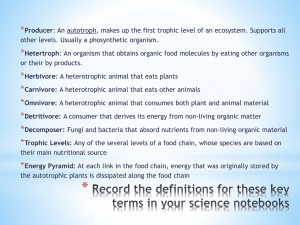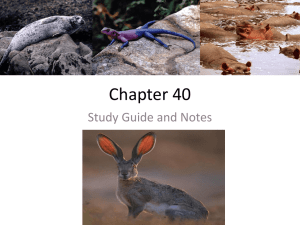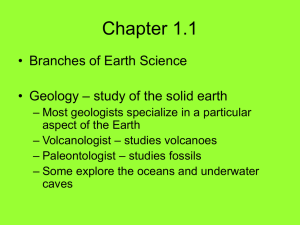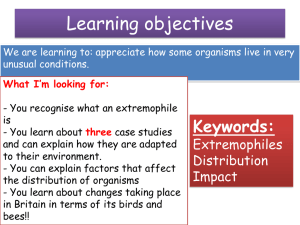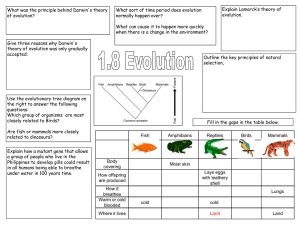Life Science With Mrs. Berg - Dunlap Community Unit School District
advertisement
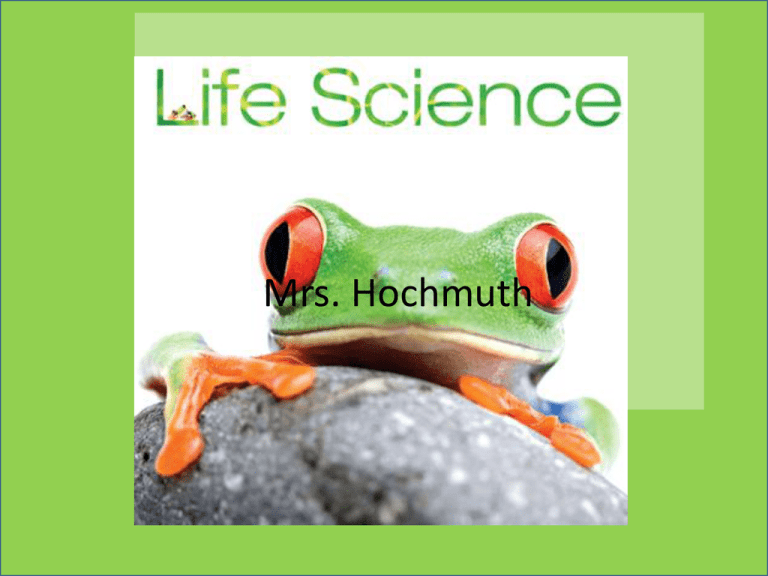
Mrs. Hochmuth What Should I Bring Everyday? • • • • • • Fusion Workbook Science Folder Science Journal Science Fair Materials Pencil & Pens Good Attitude! What Will We Do Everyday? • Make Observations – Write in our Science Journals • Preform Labs – Launch Labs, Mini Labs and Unit Labs • Gain Understanding – Reading for information – Creating lesson note outlines – Define vocabulary terms • Provide Evidence – – – – Active reading questions Lesson review questions Lesson quizzes Module Quest Where Can I Find Things In The Classroom? • • • • • • • • Extra School Supplies Homework Turn In Tray Replacement Handouts Absent Work Graded Work Goals For The Day Class Announcements Additional Resources What Are The Classroom Rules? • Respect yourself, others, and property. • Stay in your seats. • Be Safe. • Follow ALL directions given by Mrs. Hochmuth. • Attempt All Tasks Before Asking For Help. What Happens If I Forget To Follow The Classroom Rules? • • • • 1st Time: Verbal Warning 2nd Time: Lunch Detention 3rd Time: Call Home 4th Time: Office Referral NOTE: Any of the above steps may be skipped if behavior is deemed severe by Mrs. Hochmuth. How Are Grades Taken? • • • • • • • Alternative Assessment & Quests = 30% Quizzes & Labs = 20% Homework = 15% Projects = 20% Vocabulary/Science Journal = 10% Positive Performance Points= 5% NOTE: – NO Late Work Will Be Accepted (Late = 0 Pts.) – 1 Daily Assignment will be dropped every quarter th 7 Grade Positive Performance Points What are Positive Performance Points? They are points earned daily for: •Bringing ALL materials to class •Displaying acceptable behavior in class; NO gum •Participating and staying engaged in class You will earn 2 points a day for a total of 10 points per week These points will be 5% of your overall grade, per class How Do I Care For The Animals In Our Classroom? (Dead and/or Alive) • • • • • Ask For Permission Before Handling Animals Wash Your Hands Before Handling Animals Handle Animals With Care And Respect Never Let Animals Out Of Sight When Handling Wash Your Hands After Handling Animals How Do I Get Involved In My School? • Sports – Baseball – Volleyball Basketball Softball Track/Cross Country Cheerleading/Poms • Team Activities – Math Counts – Chorus Band/ Orchestra Scholastic Bowl Speech Intramurals • Clubs – Art Club Robotics Chess • Student Council- OH YES! J.A.M Spartan Learning Community • SLC is a time for working on AR and AM. • No Talking Or Working On Homework Is Allowed. • Bring Only Your READING BOOK to class on AR days. Your AM folder will be in your SLC class for AM days. • You may scan your AM exercises, practices, and tests in my classroom. I can also print off any assignments you need printed for AM. • The Library may be visited by one student at a time. You must sign out with your SLC teacher. • Use 7th Grade House computers to take AR reading tests. • Fill in any logs or questionnaires when you have completed an AR book. What Are Alternative Assessments • An Alternative Assessment is any means other than a paper/pencil test to evaluate understanding. • Alternative Assessments may include one or more of the following: – Brochure/ Pamphlet – Diary/ Journal – Song/ Rap – Model /Diorama – Quiz Board Cartoon/ Comic News Report Play/ Skit WebQuest Poster/ Power Point Assessment Menu • Choose 4 activities to complete per unit. • Each activity will be 25 points each. These activity assessments will take the place of a unit test. • Once you have completed an activity, you CAN NOT pick that activity again this school year. • There are 6 units that will be introduced over the school year. You will have a total of 24 activities completed by the end of the school year. • Do not spend a lot of money on these activities. Use the materials you have around the house. I have basic materials you can use or have here in the classroom. I suggest spending no more than a dollar or two on any activity. Life Science Unit #1 The Scientific Method How can science provide answers to your questions about the world around you? Science Journal #1: Vacuuming Coral? No, these two divers are collecting data about corals in waters near Sulawesi, Indonesia. They are marine biologists, scientists who study living things in oceans and other saltwater environments. 1. What info about corals are these scientists collecting? 2. What questions do they hope to answer? Lesson #1: Understanding Science • What is Science? – The investigation and exploration of natural events and of the new information that results from those investigations. • What behaviors do scientist use in problem solving? – Reasoning, – Creativity, – Skepticism Lesson #1: Understanding Science • What are the branches of Science? – Life Science • The study of all living things – Earth Science • The study of Earth including its landforms, rocks, soil and forces that shape Earth’s surface. – Physical Science • The study of chemistry and physics Lesson #1: Understanding Science • What is Scientific Inquiry? – Observation: Using one or more of your senses to gather information and take note of what occurs. – Prediction: A statement of what will happen next in a sequence of events. – Hypothesis: A possible explanation about an observation that can be tested by scientific investigations. – Inference: A logical explanation of an observation that is drawn from prior knowledge or experience. Lesson #1: Understanding Science • How do you write a GOOD hypothesis? – A GOOD hypothesis provides a possible outcome and explanation for the outcome. – Example: • Some plants are growing more quickly than other plants because they are receiving more water than the others. Lesson #1: Understanding Science • What are some outcomes of Scientific Inquiry? – Technology: The practical of scientific knowledge, industrial or commercial use. (Computer controlled limbs) use especially for – New Materials: bone bioceramic mimics natural bone structure – Possible explanations: Answers the Who? What? Where? Why? When? Lesson #1: Understanding Science • What is a scientific THEORY? – An explanation of observations or events based on knowledge gained from many observations and investigations – Example: The Cell Theory • What is a scientific LAW? – Describes a pattern or an event in nature that is always true. – Example: The Law Of Conservation Of Mass Lesson #1: Understanding Science • How are Scientific Theory and Scientific Law Similar? – Both will be rejected if new observations do not support the theory or law. – Both are based on repeated observations • How are Scientific Theory and Scientific Law Different? – Scientific Theory explains WHY something happens – Scientific Law states that something WILL happen. Lesson #1: Understanding Science • Where does reliable information come from? – Media: News papers, television, radio and magazines – Important to ask.. • Is the information truthful? • Is the information accurate? • What is Critical Thinking? – Comparing what you already know with the information you are given in order to decide agree with it. whether you Lesson #1: Understanding Science • What keeps a Scientific Investigations accurate? – Good investigations: • Prevent BIAS- prejudice towards a specific outcome. • Incorporate RANDOM SAMPLING- method of data collection that involves studying small amounts of something in order to learn about the larger whole. • Utilize a BLIND STUDY- the investigator, subject or both do not know which item they are testing (placebo) • Are REPEATABLE- results must consistent among all trials Lesson #1: Understanding Science • How do scientists stay safe during investigations? – Wear appropriate safety equipment – Recognize hazards and safety symbols • How do ethics fit into scientific investigation? – Ethics: rules of conduct or moral principles – Living things should be treated with care – Scientists should tell research participants about potential risks and benefits of the research – Anyone should be allowed to refuse participation Science Journal #2: Understanding Science 1. What is scientific inquiry? 2. What are the results of scientific investigations? 3. How can a scientists minimize bias in a scientific investigation? Steps of the Scientific Method • Ask Questions/State the Question – Make observations, State the problem, Gather information, • Research/Collect Information – Provide background information about topic • Hypothesis – Predict the answer to your problem • Experiment/Test your Hypothesis – Design a test to confirm or disprove your hypothesis • Analysis/Study your Data – Graph results, classify information, make calculations • Conclusion – Communicate results – You may have to retest Lesson #2: Measurement And Scientific Tools • How do description and explanation relate to observation? – Descriptions are spoken or written summary of observations. – Explanations are interpretations of observations • How do scientists use the International System of Units? – Scientists use the same internationally accepted system for measurement called SI units to make sure information can be shared and understood internationally. Lesson #2: Measurement And Scientific Tools • What measurement units do scientists use? SI Basic Units Of Measure Quantity Measured Unit (Symbol) Length Meter (m) Mass Kilogram (kg) Time Electric Current Temperature Substance Amount Light Intensity Second (s) Ampere (A) Kelvin (K) or Celsius (⁰C) Mole (mol) Candela (cd) Lesson #2: Measurement And Scientific Tools • A prefix can be added to a base unit’s name to indicate either a fraction or a multiple of that Prefixes base unit. Prefix Meaning • Can be written Mega- (M) 1,000,000 X – 1Kilometer or 1 km Kilo- (k) 1,000 X Hecto- (h) 100 X Deka- (da) 10 X Deci- (d) .1 X Centi- (c) .01 X Milli- (m) .001 X Micro- (µ) .0001 X Lesson #2: Measurement And Scientific Tools • How are Accuracy and Precision related? – Accuracy: Description of how close a measurement is to an accepted true value. – Precision: Description of how similar or close measurements are to each other. Lesson #2: Measurement And Scientific Tools • How are Accuracy and Precision measurements limited? – Tools used • Measurements taken are only as accurate as the tools used to gather them. – Degree Of Rounding • Significant digits in a measurement include all digits you know for certain plus one estimated digit. Lesson #2: Measurement And Scientific Tools • How do you know if a digit is Significant? – All nonzero numbers are significant – Zeros between nonzero digits are significant – Final zeros used after the decimal point are significant – Zeros used solely for spacing the decimal point are NOT significant. The zeros indicate only the position of the decimal point. Lesson #2: Measurement And Scientific Tools • What tools do ALL Scientists use? – Science Journals: Record descriptions, explanations, plans, and steps used in a scientific inquiry. – Balances: Used to measure Mass. – Thermometer: Used to measure temperature of substances in ⁰C. – Glassware: Used to hold, pour, heat and measure liquids Lesson #2: Measurement And Scientific Tools • What tools do ALL Scientists use? – Compound Microscopes: Used to observe small objects that you cannot observe with just your eyes. – Computers (hardware and software): Used to compile, retrieve, and analyze date for reports. Lesson #2: Measurement And Scientific Tools • What tools do Life Scientists use? – Magnifying Lens: Hand-held lens that magnifies, or enlarges, an image of an object. – Slide: Thin rectangular piece of glass used to hold specimen for microscope observation. – Dissecting Tools: (scalpels & scissors) used to examine tissues, organs, or prepared organisms. – Pipette: Small glass or plastic tube used to draw up and transfer liquids. Science Journal #3 Measurement and Scientific Tools 1. What is the difference between accuracy and precision? 2. Why should you use significant digits? 3. What are some tools used by life scientists? Skill Practice#1: Follow a Procedure Scientists often follow procedures developed by other scientists to collect data. A procedure is a step-by-step explanation of how to accomplish a task. The steps in a procedure tell you what materials to use, how to use them, and is what order to perform specific tasks. Skill Practice #1 Follow a Procedure How can you build your own scientific instrument? Skill Practice#1: Follow a Procedure Apply It: Answer the following in your science journal 1. Draw a diagram of your set up also known as a eudiometer. Label all the parts, and describe their functions. 2. Describe a scenario in which a life scientist would use this instrument to measure gases. Lesson #3: Case Study • What is biodiesel? – Fuel made primarily from living organisms such as plants and plantlike organisms. (algae) • How are variables used in experiments? – Variable: any factor in an experiment that can have more than one value. – Independent Variable: Factor you want to test. – Dependent Variable: Observable outcome dependent on Independent variable. Lesson #3: Case Study • What are some arguments against using biodiesel as a primary fuel source? – Petroleum: historically petroleum, a type of refined fossil fuel, has cost less to produce. – Sources of biodiesel: Some are concerned that farmers will begin growing crops for only fuel production instead of food production. Lesson #3: Case Study • How did scientists discover fuel from plants? • Aquatic Species Program (ASP) 1970s – Original Focus: To use large and small plants to remove excess Carbon Dioxide produced by coal energy plants. – Shifted Focus: Uncovered that some small plants called microalgae produced large amounts of oil after taking in Carbon Dioxide. Lesson #3: Case Study • How did scientists turn their observation into an experiment? • Step #1- Create a tentative explanation that can be tested by scientific investigation – Hypothesis: Some microalgae species can be used as a source of biodiesel fuel because the microalgae produce a large amount of oil. – Challenge: Finding the correct species of microalgae, and growing conditions to produce large amounts of oil. Lesson #3: Case Study • Step #2: Design an experiment and collect data – ASP developed a rapid screening test to discover which micro-algae species produced the most oil – Independent Variable: Amount of nitrogen given – Dependent Variable: Amount of oil produced – Constants: growing conditions (temperature, light water quality) Lesson #3: Case Study • Step #3: Observe impact of independent variable – Less Nitrogen resulted in… smaller sized micro-algae organisms less overall oil production • Step #4: Revise Hypothesis and design 2nd test - Hypothesis: If light is distributed more evenly then more microalgae will grow and more oil will be produced Lesson #3: Case Study • Step #5: Design 2nd controlled experiment to test new hypothesis. – Where could Microalgae be grown? • Open Ponds • Plastic Bags • Glass Bioreactors • What does it mean for an experiment to be hypothesis driven? - To develop research strategies or experiments based on hypothesis. Lesson #3: Case Study • What is the difference between a prediction and a hypothesis? – Hypothesis: A possible explanation that can be tested – Prediction: A statement of what someone expects to happen next in a sequence of events. • If light is distributed more evenly then more microalgae will grow, and more oil will be produced. Lesson #3: Case Study • Step #6: How to distribute light evenly? – Bring light to Microalgae = Light rods – Bring Microalgae to the light = Paddle Wheels • Step #7: Analyze Results – Results showed that microalgae would produce more oil using light rods than just sun light • Step #8: Draw conclusion – Light rod system greatly increased microalgae oil production Lesson #3: Case Study • Examine Benefits of Microalgae – Removes carbon dioxide pollution – Produces Carbohydrates, and Lipids • Used for Biodiesel, Bioethanol, Human and livestock food, and pharmaceuticals and cosmetics – Adds Oxygen back to the environment • Is Microalgae The Future? Science Journal #4 Case Study 1. How do independent and dependent variables differ? 2. How is scientific inquiry used in real-life scientific investigation? Inquiry Lab #1: Design A Bioreactor How can you design a bioreactor? Inquiry Lab #1: Design A Bioreactor • Analyze And Conclude 1. What conditions resulted in the fastest growth of yeast? 2. Which of the two variables had a greater influence on the growth of yeast? How did you draw that conclusion? 3. Which scientific processes did you use in your investigation of bioreactors? Life Science Unit #2 Classifying and Exploring Life What are living things, and how can they be classified? Science Journal #5: Innovative Bird Nest Building? At first glance, you might think a very strange bird has made a unique nest on the ground, but the object in the “nest” is no egg. 1. What do you think the object is? Is it alive? 1. What are living things, and how can they be classified? Launch Lab #1: Is It Alive? 1. Place three pieces of pasta in the bottom of a clear cup. 2. Add carbonated water to the cup until it is 2/3 full. 3. Observe the contents of the cup for 5 minutes. Record you observations in your science journal. Launch Lab #1: Is It Alive? Think About This! 1. Think about living things. How do you know they are alive? 2. Which characteristics of life do you think you are observing in the cup? 3. Is the pasta alive? How do you know? Lesson #1: Characteristics of Life • What determines if something is living or nonliving? – Only things that have ALL the characteristics of life are considered living, these living things are called organisms. • What are the 6 characteristics of life? 1. Organization • Living things are made of cells- the smallest unit of life • Living things that are made of only one cell are called unicellular • Living things that are made of more than one cell are called multicellular. Lesson #1: Characteristics of Life • What are the 6 characteristics of life? 2. Growth and Development • When organisms grow they increase in size – Multicellular organisms grow as number of cells increase – Unicellular organisms grow as the cell size increases • Changed that occur in an organism during its life time are called development. Lesson #1: Characteristics of Life • What are the 6 characteristics of life? 3. Reproduction: The process by which one organism makes one or more new organisms. • Some organisms can reproduce by dividing and becoming two new organisms • Other organisms have specialized cells for reproduction that may or may not require a mate to reproduce. Lesson #1: Characteristics of Life • What are the 6 characteristics of life – Response to Stimuli • Internal Stimuli: Response to internal body signals – Example: if you feel hungry or thirsty you look for food or water. • External Stimuli: Response to environmental changes – Example: Response to light and temperature. Lesson #1: Mini Lab Did You Blink? Like all living organisms, you respond to changes, or stimuli, in your environment. When you react to a stimulus without thinking, the response is known as a reflex. Lets see what a reflex is like. Lesson #1 Mini Lab Did You Blink? 1. Sit in a chair with your hands in you lap. 2. Put on your safety goggles 3. Have your lab partner gently toss a soft foam ball at your face five times. Your partner will warn you when he or she is going to toss the ball. Record your responses in your science journal. 4. Have your partner gently toss the ball at your face five times without warning you. Record your responses. Lesson #1 Mini Lab Did You Blink? Analyze and Conclude 1. Compare your responses when you were warned and when you were not warned. 2. Decide if any of your reactions were reflex responses, and explain your answer. 3. Infer whey organisms have reflex responses to some stimuli. Lesson #1: Characteristics of Life • What are the 6 characteristics of life? – Homeostasis: Organisms ability to maintain steady internal conditions when outside conditions change. • By maintaining certain conditions – Homeostasisensures that cells can function. • If cells cannot function normally, then the organisms might become sick or even die. Lesson #1: Characteristics of Life • What are the 6 characteristics of life? – Energy • Cells continuously use energy to transport substances, make new cells, and perform chemical reactions. • For most organisms this energy comes to Earth from the sun. • Example: – Plants get energy from the sun to grow – Deer get energy from the plants they eat – Mountain lions get energy from the Deer they eat Science Journal #6 Characteristics Of Life 1. What characteristics do all living things share? Lesson #2: Classifying Organisms Launch Lab #2 How do you identify similar items? Launch Lab #2 Do you separate your candies by color before you eat them? When your family does laundry, do you sort the clothes by color first? Identifying characteristics of items can enable you to place them into groups. Launch Lab #2 1. Examine 12 leaves. Choose a characteristic that you could use to separate the leaves into two groups. Record the characteristic in your Science Journal. 2. Place the leaves into two groups, A and B, using the characteristic you chose in step #2 3. Choose another characteristic that you could use to further divide group A. Record the characteristic and divide the leaves 4. Repeat step #3 for group B. Launch Lab #2 Think About This! 1. What types of characteristics did other groups in class choose to separate the leaves? 2. Why would scientists need rules for separating and identifying items? Lesson #2: Classifying Organisms • How have organisms been classified in the past? – Ancient Greek philosopher Aristotle, one of the first people to classify organisms, placed all organisms into two groups: Plants or Animals – Aristotle classified animals based on shape and size, the presence of “red blood,” their environment – Aristotle classified plants based on the structure and size of the plant and whether it was a tree, shrub or herb. Lesson #2: Classifying Organisms • How are organisms classified today? – In the 1700s Carolus Linnaeus, a Swedish physician, placed all organisms into two main groups he called kingdoms. – In 1969 American Biologist Rober H. Whittaker prosed 5 kingdoms of classification: Monera, Protista, Plantae, Fungi and Animalia Lesson #2: Classifying Organisms • Today Scientists use a system of Domains (3) and Kingdoms (6) to classify organism • Domains: Bacteria, Archaea, and Eukarya • Kingdoms: Bacteria, Archaea, Protista, Fungi, Plantae, and Animalia Lesson #2: Classifying Organisms • How do Scientists use names to help classify organisms? – When Linnaeus grouped organisms into kingdoms, he also developed a naming system called binomial nomenclature. – Binomial nomenclature gives each organism a two word scientific name, a genus name and a species name. – Genus: group of similar species – Species: group of organisms with similar traits and are able to produce fertile offspring. Lesson #2: Classifying Organisms • Why Are Scientific Names important? – Each species has its own scientific name – Scientific names are the same worldwide – Universal names make communication about organisms more effective because everyone uses the same name for the same species. Lesson #2: Classifying Organisms • How do scientists use tools to classify organisms? – Dichotomous Key: Series of descriptions arranged in pairs that leads the user to the identification of an unknown organism. – Cladograms: Branched diagram that shows the relationship among organisms, including common ancestors. Lesson #2: Classifying Organisms Mini Lab How would you name an unknown organism? Lesson #2: Classifying Organisms Mini Lab Assign scientific names to four unknown alien organisms from a newly discovered planet. 1. Use the table to assign scientific names to identify each alien. 2. Compare your names with your classmates. Prefix mon– di– rectanguli– trianguli– Meaning Suffix one two square triangle –antennius –ocularus –formus –uris Meaning antenna eye shape tail Lesson #2: Classifying Organisms Mini Lab Analyze and Conclude 1. Explain why you chose the two-word names for each organism. 2. Compare your names to those of a classmate. Explain any differences. 3. Discuss how two-word scientific names help scientists identify and organize living things. Science Journal #7 Classifying organisms 1. What methods are used to classify living things into groups? 2. Why does every species have a scientific name? Skill Practice #2: Classify A dichotomous key is one of the tools scientists use to identify an unknown organism and classify it into a group. To use a dichotomous key, a scientist examines specific characteristics of the unknown organism and compares them to characteristics of known organisms. Skill Practice: Classify How can you identify a beetle? Skill Practice: Classify Apply It! 1. Think about the choices in each step of the dichotomous key. What conclusions can be made if you arrive at a step and neither choice seems correct? 2. Predict whether a dichotomous key will work if you start at a location other than the first description. Support your reasoning. 3. How did the dichotomous key help you classify the unknown beetle? Lesson #3: Exploring Life Launch Lab #3 Can a water drop make objects appear bigger or smaller? Launch Lab #3 For centuries, people have been looking for ways to see objects in greater detail. How can something as simple as a drop of water make this possible? Launch Lab #3 1. Lay a sheet of newspaper on your desk. Examine a line of text, noting the size and shape of each letter. Record your observations in your Science Journal. 2. Add a large drop of water to the center of a piece of clear plastic. Hold the plastic about 2 cm above the same line of text. 3. Look through the water at the line of text you viewed in step 2. Record you observations. Launch Lab #3 Think About This! 1. Describe how the newsprint appeared though the drip of water. 2. How might microscopes change your ideas about living things? Lesson #3: Exploring Life • How have microscopes changed the world? – The invention of the microscope enabled people to see details of living things that they could not see with the unaided eye. – The microscope also enabled people to make many discoveries about living things. Lesson #3: Exploring Life • What were the first microscope like? – In the late 1600s Anton van Leeuwenhoek, a Dutch merchant, Made one of the first microscopes. – The microscope had one lens and could magnify an image about 270 times its original size. – Leeuwenhoek used his microscope to observe pond water and insects. – In the early 1700s Robert Hooke used a microscope to observe cells proving that all living things are made of cells. Lesson #3: Exploring Life • What characteristics do all microscopes share? – All microscopes magnify objects – All microscopes improve the resolution of an object (how clearly details can be seen) • How many different types of microscopes are there? – Light microscopes – Electron microscopes Lesson #3: Exploring Life • What are Light Microscopes? – Light microscopes use light and lenses to enlarge an image of an object. – Compound light microscopes use more than one lens to magnify an object. • Magnifies first by the objective lens then by the ocular lens • Total magnification is equal to the magnification of the objective lens multiplied by the magnification of the ocular lens. Lesson #3: Exploring Life Practice! 1. What is the magnification of a compound microscope with a 10X ocular lens and a 4X objective lens? Lesson #3: Exploring Life • What are light microscopes? – Light microscopes can enlarge up to 1,500 times – Resolution is about 0.2µm (you can clearly see points on an object that are at least 0.2µm apart) – Simple Light Microscopes use light and one lens – Compound Light Microscopes use light and more than one lens (ocular and objective lenses) – Can use to observe objects directly under microscopes as well as those mounted on slides. Lesson #3: Exploring Life • What are Electron Microscopes? – Electron microscopes use a magnetic field to focus a beam of electrons through an object or onto an object or onto an objects surface. – Electron microscopes can magnify up to 100,000 times or more – Resolution can be as small as 0.2 nanometers (1,000 times greater than a light microscope) Lesson #3: Exploring Life • What are Electron Microscopes? – Transmission Electron Microscopes: used to study very small nonliving things sliced thin and mounted in plastic. – Scanning Electron Microscopes: used to study the surface of objects by bouncing electrons to produce a 3 dimensional image. Lesson #3: Exploring Life • What are some uses for microscopes? – Healthcare • Used by doctors during surgeries such as eye and brain surgery. • Used by lab technicians to analyze body fluids and to determine if body tissues are healthy or diseased. – Other: • Used by forensic scientists to study evidence from crime scenes • Used by biologists to study populations of organisms • Used to study jewelry Lesson #3: Exploring Life Mini Lab A microscope enables scientists to study objects in greater detail than is possible with the unaided eye. Compare what objects look like with the unaided eye to those same objects observed using a microscope. Lesson #3: Exploring Life 1. Examine a sea sponge, a leaf, and salt crystals. Draw each object in your Science Journal 2. Observe microscope slides of each object using a microscope on low power. 3. Draw each object as it appears under low power. Lesson #3: Exploring Life Analyze and Conclude 1. Compare your sketches of the object observed wit your unaided eye and observed with a microscope. 2. Explain how studying an object under a microscope might help you understand it better. Science Journal #8 Exploring Life 1. How did microscopes change out ideas about living things? 1. What are the types of microscopes and how do they compare? Inquiry Lab: Constructing a Dichotomous Key How can you create a dichotomous key to identify objects? Inquiry Lab: Constructing a Dichotomous Key Analyze and Conclude 1. Was the other team about to correctly identify the collection of objects using your dichotomous key? Why or why not? 2. Summarize how dichotomous keys are useful in identifying unknown objects.
